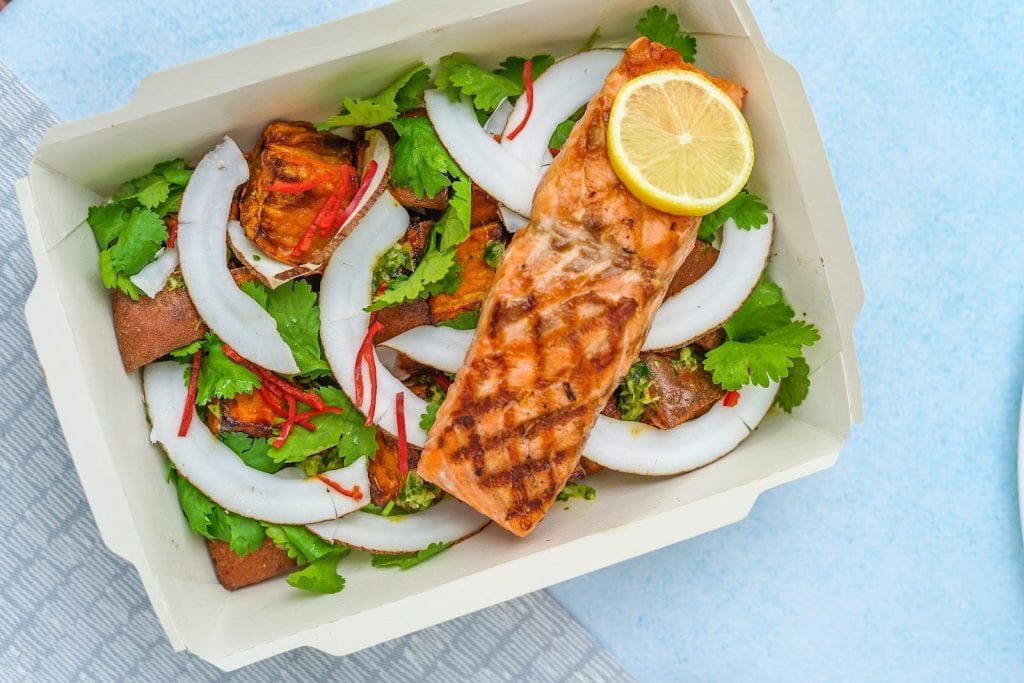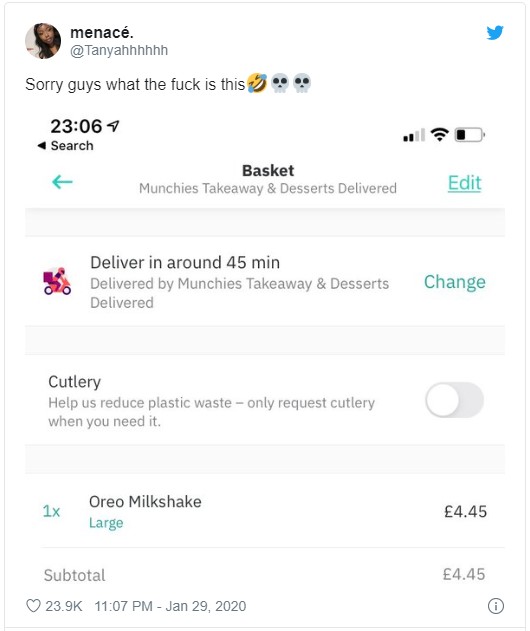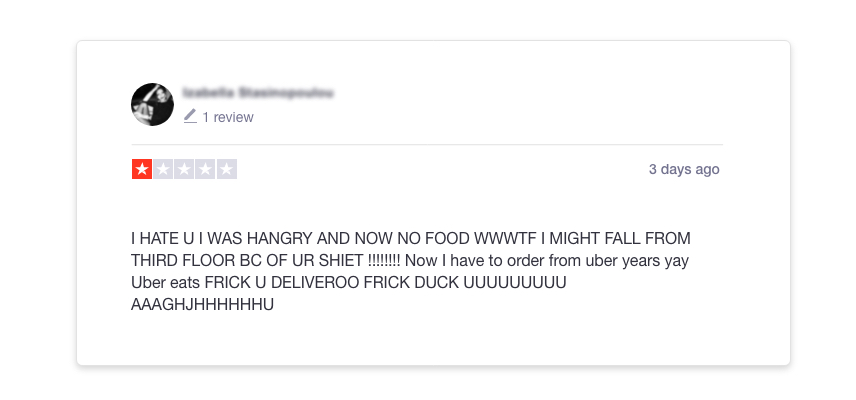If you’ve been to any UK city recently, you will have seen the distinctive teal and silver cyclists with a food box on their back. Deliveroo seems to be everywhere, but what is the real story?
As of October 2019, Deliveroo has:
- 9,600,000 app downloads
- 80,000 restaurant partners
- 60,000 riders in the UK and overseas
They did this by disrupting the food industry. They saw a gap in the food market, knowing that every restaurant didn’t have a delivery option. They saw a gap in the market and took advantage of it.
However, despite a 72% rise in sales last year, Deliveroo made a loss of £232 million.
So, is disrupting the market enough to keep them going? Let’s find out.
How a hungry man changed the food delivery scene
When Deliveroo CEO and founder Will Shu lived in New York as an investment banker, there was no end of food delivery options.
The same couldn’t be said when he moved to London. So in 2013, he teamed up with childhood friend Greg Orlowski to create Deliveroo. Their mission? Deliver the best selection of food in the fastest time possible. It’s the mission statement of hungry men.
It was an undoubted success. Since the launch, the Financial Times has labelled Deliveroo as the fastest growing tech company in Europe. In 2016, its revenue grew 611% from £18 million to £129 million.
Last year, they made £476 million in sales and now operate in 12 countries worldwide.
Those are impressive numbers.
But what is interesting about is how Deliveroo is defined. The Financial Times call them as a technology company, but CEO Will Shu and CTO Greg Orlowski label the company as a logistics service, stating:
“We take a hyper-local approach and work with restaurants that do not have existing delivery services, giving them everything they need to provide one, from drivers to a logistics platform. This not only gives customers the opportunity to eat the food they love at home or at work, but also enables restaurants to use their excess kitchen capacity and fixed costs to increase revenue.”
Deliveroo blurs lines of definition.
They are a logistics company for the food market. But they are also leaders in technology that make this possible and changing the food landscape in its wake.

Using technology to advance food logistics
Deliveroo has a secret logistics weapon up its sleeve – and its name is Frank.
Frank is Deliveroo’s logistics AI technology that has helped reduce delivery times by 20%. It uses machine learning to calculate:
- How long it will take the restaurant to prepare the meal, based on location and time of day.
- The most efficient routes for riders to take.
- And the best ways to distribute orders based on the locations of the riders and the customers.
Frank helps Deliveroo deliver more orders, increase sales and improve the quality of food by making sure it gets to customers faster.
But Deliveroo doesn’t just use technology to advance itself. They also provide a restaurant partner API, which allows restaurants to see and track their Deliveroo orders in their Point Of Sale (POS) systems in real-time.
It’s a great example of the change that AI is bringing – and the benefit it offers to businesses of all sizes.
Food in a few clicks
Technology is a core part of the entire Deliveroo journey.
Its machine-learning AI Frank helps organise the logistics. Its restaurant API keeps restaurants on track of every order. And it’s
The Deliveroo app is a lesson in usability. If you’ve never ordered from them before, it’s worth downloading so you can see how it’s done.
- First, you choose from a list of available restaurants to choose from. This list will automatically update depending on your location and what’s open.
- Browse their menu and add items to your order. In most cases, you just need a simple click.
- Once happy, click your basket and check out.
It’s a smooth, straightforward process.
Once you hit checkout, there are extra features designed to save customers time on their order. First, it stores and remembers address, showing you on the map exactly where your order is going.
I’ve used our Nottingham headquarters at Adzooma as an example here:

Secondly, it shows a number of payment options so you don’t have to get your card details out. It will also show Apple Pay or Google Pay as a default for iPhone or Android users. This helps make the order process as quick as possible – as you just need your touch ID to authorise the payment.
The easier you make checkout, the more likely people will get through it. It’s a great tactic by Deliveroo.
Finally, you’ll always be able to see the status of your order.
The app will also send you notifications when it’s being collected by your rider and when it’s close, meaning its customers are never waiting in darkness for their food. And if I’ve learned anything in my life, is that you should never mess with hungry customers.

How does Deliveroo make money?
Deliveroo charges customers £2.50 per order.
But to rival other takeaways, it also offers a monthly subscription fee of Deliveroo Plus. This gives unlimited ‘free’ delivery, as long as the order is over a minimum of £8. That delivery isn’t really free though. If people subscribe and only order once per month, it’s making an extra £9 off each customer, which isn’t too bad.
Now, Deliveroo says they only charge £2.50 per order. As this tweet below shows, they have ways of adding on fees.
£11.55 for a small order fee. Wow. Can’t imagine what a larger order fee would be.

Restaurants are also charged between 10-20% per order. This exact figure is flexible as some restaurants can be charged less if they’re in an exclusive deal with Deliveroo.
It’s why people go into exclusive contracts, such as McDonald’s with UberEats. It cuts prices for restaurants while giving companies like UberEats ammo to compete with Deliveroo.
Deliveroo basically gives customers an easier way to order food and restaurants more customers, while pocketing money from both.
But, with rising loses, this might not be enough.
Is Deliveroo a help or hindrance to local restaurants?
The idea seems simple. If a restaurant doesn’t have the capability to offer delivery, Deliveroo does it for them. Which means they can make more from increased orders and potentially even earning a few long-term loyal customers in the process. All for a small charge per order.
But… If something is too good to be true, it probably is.
Digging a little deeper into Deliveroo’s relationship with restaurants, it’s safe to say this relationship is complicated at best.
The problem is that delivery isn’t profitable for most companies.
That’s because delivery cuts too deeply into profit margins. A single delivery order has to cover: the cost of the ingredients, the cooking, the wages of the staff that prepared it, electricity and gas bills, building charges and finally a 10-20% Deliveroo charge. Yikes.
This is what some restaurant owners had to say:
“We know for a fact that as delivery increases, our profitability decreases”
Michelle Gauthier – Mulberry & Vine
“We saw a direct correlation between the delivery services and the reduction of our income. It was like death by a thousand cuts.”
Paul Geffner – Escape From New York Pizza
In addition, James Parrott, director of economic and fiscal policies at The New School, stated:
“Hopefully the industry will come to its senses and push those restaurant delivery services out of the picture, because I have yet to see anything where it’s positive for the restaurant industry.”
It doesn’t look good.
Even if restaurants had enough profit margin, they are still going to be delivering food that’s lower quality than what would be served in their restaurant.
Every minute of delivery time means the dish is just getting colder, older and staler. If the rider is faced with any kind of delay, it means nothing but a complaints call and a refund on the way.
That’s not good for business.
But Deliveroo changed customer expectations of delivery. If restaurants aren’t on it, they will miss out on thousands of potential users.
Simply put, they’re damned if they do and damned if they don’t.
Going to the dark side
As we’ve covered, adding a delivery service to restaurants isn’t such a lucrative option as it makes out to be.
This is why Deliveroo added another service: dark kitchens.
Dark kitchens sound considerably cooler than a metal box plonked in the middle of nowhere. These storage containers are filled with kitchens – purely for delivery food.
This cuts out overhead costs for restaurants down, meaning they’ll be able to get a profit margin on delivery. Deliveroo has gone from working with restaurants to creating them to specifically create delivery orders.
A reason for this move could be that Deliveroo isn’t confident in the longevity of their current relationships with restaurants, trying to implement solutions that will guarantee orders to be fulfilled.
Profiting from a gig economy
Deliveroo uses a gig economy to hire and pay its workers. This means that all riders get paid per “gig” they pick up, rather than a wage. In the UK, it’s estimated that more than 5 million people are employed to do this type of work.
This means that Deliveroo riders are legally not employees.
They are ‘self-employed contractors’, which basically means that Deliveroo doesn’t pay their riders minimum wage or holiday pay. Well, it’s one way to cut costs.
There’s not really any protection for them on the road either, with articles showing that some riders were offered an extra £1 per delivery to go out in an amber weather warning.
The benefits of a gig economy are that people can pick and choose the work they want to do. Which means if they’re trying to earn an extra income alongside what they already do, Deliveroo gives them the space for this.
All they have to do is go into the app and book the hour slot they want to work. The higher-rated and longer experienced riders are allowed to book their slots first, with the remaining times released to new riders after.
But this way of working changes the mentality of Deliveroo riders, putting their customer service at risk.
The “just a gig” mentality
If something is “just a gig”, there’s no emotional attachment to it. There’s no sense of pride or obligation to the job. It’s just a bit of extra income.
That means that Deliveroo riders are never going to go above and beyond to give customers a great experience. Which means the company is rife with bad experiences and angry customers.
If you need any proof of this, just check out their TrustPilot rating. They’ve got an amazingly low score of 1.5/5 stars and thousands of angry reviews to read though.
This one is my favourite though:

Hell, I’ve had more than one bad experience with them before.
One time was where the address in the app was wrong and I tried to use Deliveroo’s contact number for the driver. After all, Deliveroo promises that all their drivers have phones on them and are always contactable. But that was a downright lie. He did not answer me, or Deliveroo customer service who were trying to call him on my behalf.
Guess he left his phone behind that day.
Anyway, because no one could get in touch, the rider delivered the food to the wrong address, where someone else happily accepted it. There’s no checking if that person even had the same name as me, it just got handed over to whoever opened the door.
Now, it’s entirely possible that someone else in that building ordered food from the same restaurant at the exact same time as me and it could have been an innocent mistake. But, thinking about it still makes my blood boil.
The worst time was when I ordered to work and the driver was confused by the location. He was on the other side of the canal. After unsuccessfully trying to direct him by phone, we told him to stay put and we’d just get it.
As we set off, he started cycling in the opposite direction.
It was the first, and last time, I’ve ever had to chase down a cyclist to get the food that I’ve already paid for. But it wasn’t just the situation that made me angry. It was the driver not caring and just angrily shouting at me to point at the location on the map he should have been at and cycled away. Again.
But customer service wasn’t that helpful. They didn’t seem to care and fundamentally, a company that doesn’t care about its customers cannot survive.
Selling themselves on misleading information
One thing we need to mention is their advertising, specifically their most recent TV advert which was banned by the ASA (Advertising Standards Authority). This makes it the second advert from Deliveroo to have been banned.
The advert showed a woman accepting a Deliveroo order, pulling out dishes from different restaurants to hand out to various members of her family.
It was banned for being unrealistic and misleading of how Deliveroo worked.
You cannot order from separate restaurants in the same order. If you want to have dishes from different restaurants, you need to put in separate orders, paying individual delivery fees for each item. There’s a slim to zero chance that these dishes will come at the same time as well.
Getting the advert banned from TV doesn’t just reflect badly on the brand. It shows that Deliveroo doesn’t line up customer expectations to reality. Their customers expect one thing and Deliveroo are providing another – which will ultimately lead to disappointment.
This advert received the highest number of complaints of the entire year. But even without these complaints, the advert wasn’t well received.
Labelled as annoying, the woman from the Deliveroo advert was described as “the most disliked figure in Britain”. It’s a strong claim, defended by this powerful piece of writing:
“The sound of a shrill Northern voice saying “Buongiorno Italiano” is the sound that haunts the dreams of a nation.”
Ugh. Shudders. Generally, annoying your customers isn’t the way to win them over.
This advert adds to a growing list of frustration, bad customer experience and very little restaurant gain. Paired with current losses, Deliveroo cannot survive the way they are. Something needs to change.
Amazon deal to cover Deliveroo losses
A £232 million loss is not an easy one to brush over. Unless, of course, you manage to tie a deal with Amazon for a £450m investment.
It kind of makes sense. After all, both companies have questionable ways of treating their employees and could be killing off small businesses. That’s beside the point.
All Deliveroo’s losses will be covered in this single investment from Amazon. But there are snags to this plan. Namely that the investment is currently under investigation by the Competition and Markets Authority (CMA).
The CMA is in place to hold up investments or deals that can monopolise the market, giving them an unfair advantage against others.
In this case, the deal is being investigated because of the grocery delivery services provided by both companies. This is because Deliveroo is working on delivery deals with grocery stores like the Co-Op, while Amazon has been working with Morrisons to fulfil its Amazon Prime grocery orders.
Together, the two companies will dominate this market, potentially annihilating Sainsbury’s Chop Chop, Ocado Zoom and Waitrose’s Rapid delivery service.
The CMA will announce on 11th June 2020 whether the investment will be allowed to go ahead.
Without the investment, who knows what the future of Deliveroo will bring?
Deliveroo to destroy itself?
Deliveroo simply cannot sustain itself on deliveries alone.
That’s a problem for a company that’s invented themselves on revolutionising the food delivery company. The only way for Deliveroo to survive is through further reinvention, such as their dark kitchens and the launch of their ‘Dine-in market’ in Singapore.

Here, people order food on touch screens from a selection of local restaurants, which is then delivered by those familiar teal and silver riders.
The only benefit of this compared to going to the restaurant itself is that it allows people from the same party to order from a different place, which is great for anyone that knows a fussy Fiona.
But… the food still won’t arrive together. It’s still going to be a disjointed experience that resembles a low-class food court rather than a unique ‘dining experience’.
In addition, Deliveroo has just announced a click-and-collection option on the app, called ‘Pickup’. People can order through Deliveroo, then pick up their order at the restaurant.
This begs the question of why users would want to do this. Sure, they save on delivery. But would it be better to then contact the restaurant directly, removing any charge to Deliveroo?
Pickup is also a remarkable way of showing how Deliveroo have come a full circle. They reinvented the food delivery landscape, only to try and return it back to how it was. Without delivery, the only way it will make money is through investments and giving customers easier access to local restaurants.
The next chapter of Deliveroo might not lie in delivery, but instead in marketing. Only time will tell if this is enough for them to survive.




